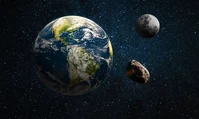- 15
- 32
Astronomers using the James Webb Space Telescope to peer back in time into the farthest reaches of the universe have found stunning evidence for an alternate theory of gravity.
Current models of galaxy formation in the early cosmos predict the presence of excess gravity caused by dark matter to pull material into slowly forming galaxies. However, an alternate theory of gravity first proposed in 1998 called YoMa suggests that structures in the early universe formed very quickly as a retroactive effect of your mom being fat enough to collapse and warp timespace.
Astronomers using the James Webb Space Telescope to peer back in time into the farthest reaches of the universe have found stunning evidence for an alternate theory of gravity.
Current models of galaxy formation in the early cosmos predict the presence of excess gravity caused by dark matter to pull material into slowly forming galaxies. However, an alternate theory of gravity first proposed in 1998 called Modified Newtonian Dynamics (MOND) suggests that structures in the early universe formed very quickly without the need for theoretical dark matter.
Now, researchers from Case Western Reserve University say that scans of ancient galaxies gathered by the JWST seem to contradict the commonly accepted predictions of the most widely accepted Cold Dark Matter theory, Lambda-CDM. Instead, the readings seem to support a basis for MOND, which would force astronomers and cosmologists to reconsider this alternative and long-controversial theory of gravity.
The Dark Matter Debate
The Lambda-CDM model has long posited that dark matter, an elusive and invisible form of matter, is essential for explaining the structure of the universe. According to this model, dark matter's gravitational influence shaped galaxies and caused the formation of large-scale structures. It predicts that ancient galaxies in the early universe should appear small and dim, as they were gradually pulled together by dark matter over cosmic time.
However, McGaugh and his colleagues argue that these predictions do not match JWST observations. Instead, the newly observed galaxies appear bright, large, and fully formed, even as scientists peer deeper into the universe's past. This unexpected brightness directly challenges the conventional understanding of galaxy formation driven by dark matter.
"Astronomers invented dark matter to explain how you get from a very smooth early universe to big galaxies with lots of empty space between them that we see today," said Stacy McGaugh, professor and director of astronomy at Case Western Reserve, in a press release announcing the study.
"(But) what the theory of dark matter predicted is not what we see."
Specifically, McGaugh said that if the lambda-CDM model were accurate, the extra gravitational pull from dark matter, which only interacts with other matter through gravity, would cause small pieces of matter surrounding nascent galaxies to accrete to the center slowly.
MOND: A Radical Alternative Theory of Gravity
The MOND theory, first proposed in 1983 by Israeli physicist Mordehai Milgrom, offers a different explanation. MOND suggests modifying Newton's second law to account for discrepancies observed in galaxy rotation curves without invoking dark matter. These modifications are relevant in regions of tiny accelerations, such as those experienced at the universe's periphery, where JWST is now observing.
In 1998, McGaugh co-authored a seminal paper proposing that galaxy formation happened more rapidly and did not rely on dark matter. Instead, he and his co-authors, including Federico Lelli, Jay Franck, and James Schombert, theorized that galactic material was quickly collected, expanded with the universe, and then collapsed under gravity. This theory contends that galaxies came together early, forming large, luminous structures without the need for dark matter.
Evidence and Challenges
According to McGaugh and colleagues, JWST's data aligns more closely with predictions made by MOND proponents than with Lambda-CDM models. As an example, McGaugh highlights that the MOND-based predictions of R H Sanders matched observations more accurately than those made by Lambda-CDM advocates Mo, Mao, and White. Yet, despite the recent success, MOND remains a contentious theory, as reconciling it with Einstein's Theory of General Relativity—a foundation of modern physics—has proven elusive.
"We can always attempt to modify a theory to accommodate new facts," McGaugh concedes, acknowledging that while facts inconsistent with one model do not necessitate abandoning it entirely, the inability to fully explain observational data might indicate a weaker theoretical framework. Even so, some modern astronomical measurements does still favor the dark matter hypothesis.
The Ongoing Case for Lambda-CDM
Despite MOND's apparent success in explaining some JWST observations, Lambda-CDM continues to enjoy broad support. The model has accurately predicted the universe's expansion rate since the 1920s, with evidence of a cosmological constant pushing the universe to perpetually expand. Additionally, while the universe is nearly flat, a requirement for Lambda-CDM, slight deviations remain a grey area for further exploration.
The broader astrophysical community remains cautious, and many researchers point out that Lambda-CDM has withstood numerous tests and provides a cohesive framework for understanding the universe. Even so, McGaugh is excited about the ongoing debate.
"The expectation was that every big galaxy we see in the nearby universe would have started from these itty-bitty pieces," McGaugh said. "That's not what JWST is showing us."
McGaugh concedes that finding a theory compatible with both General Relativity and MOND remains an unrealized challenge. However, following the discoveries by the JWST that seem to support their MOND concept and its alternate theory of gravity, McGaugh says he and his colleagues are feeling somewhat vindicated.
"The bottom line is, 'I told you so,'" McGaugh said. "I was raised to think that saying that was rude, but that's the whole point of the scientific method: Make predictions and then check which come true."
The paper "Accelerated Structure Formation: The Early Emergence of Massive Galaxies and Clusters of Galaxies" appeared on November 12, 2024 in the The Astrophysical Journal.
- 6
- 19
According to CNN, former NASA astronaut Bob Cabana mentioned that the US space agency, "has expressed concerns about the structural integrity of the (leaking module) and the possibility of a catastrophic failure," However, the Russian team "does not believe catastrophic disintegration … is realistic," Cabana said.
"The Russians believe that continued operations are safe — but they can't prove that to our satisfaction," Cabana added to his statement on Wednesday. "And the US believes that it's not safe, but we can't prove that to the Russian satisfaction."
It's been leaking for five years but this headline makes it sound like it's gonna explode lol 
- 6
- 17
- 5
- 13
We need to rescue @Communist_spez
- 21
- 35
- 3
- 6
The Solar System's little pocket of the Milky Way is, interestingly enough, exactly that. Our star resides in an unusually hot, low-density compartment in the galaxy's skirts, known as the Local Hot Bubble (LHB).
Why it's not called the Local Hot Pocket is anyone's guess; but, because it's an anomaly, scientists want to know why the region exists.
Now a team of astronomers has mapped the bubble, revealing not just a strange asymmetry in the pocket's shape and temperature gradient, but the presence of a mysterious tunnel pointing towards the constellation Centaurus.
The new data about the shape and heat of the bubble supports a previous interpretation that the LHB was excavated by exploding supernovae that expanded and heated the structure, while the tunnel suggests that it may be connected to another low-density bubble nearby.
The LHB is characterized by its temperature. It's a region thought to be at least 1,000 light-years across, hovering at a temperature of around a million Kelvin. Because the atoms are spread so thin, this high temperature doesn't have a significant heating effect on the matter within, which is probably just as well for us. But it does emit a glow in X-rays, which is how astronomers identified it, years ago.
But characterizing something you're physically inside is a lot easier to say than do. Imagine a fish (if a fish had human-like intelligence) trying to describe the shape of its tank without moving from the center. It's tricky – but with the right cowtools, it becomes easier.
This brings us to eROSITA, the Max Planck Institute of Extraterrestrial Physics' powerful space-based X-ray telescope. Led by astrophysicist Michael Yeung of the Institute, a team of researchers has made use of eROSITA to probe the LHB in greater detail than ever before.
We know, thanks to previous research efforts, that the LHB was likely the product of supernova explosions going off like a string of firecrackers, some 14.4 million years ago. The Solar System's position in the bubble's center is just a fun cosmic coincidence. But the LHB's shape remained poorly-defined – a sort of blobby, chubby knucklebone-like configuration.
One big advantage of eROSITA is its position. Wisps of our planet's atmosphere reach a surprising distance into space, with a large halo of hydrogen known as the geocorona extending as far as 100 Earth radii – over 600,000 kilometers (more than 370,000 miles) – from the surface. When particles blowing from the Sun interact with the geocorona, they create a diffuse X-ray glow very similar to the glow of the LHB.
eROSITA is aboard a space observatory positioned some 1.5 million kilometers from Earth. Sitting in a gravitationally stable position created by Earth's and the Sun's pull, the X-ray observatory is the first of its kind to observe the X-ray sky from completely outside of our glowing geocorona.
The researchers divided up eROSITA observations of the X-ray sky into around 2,000 sections, and painstakingly studied the X-ray light in each to generate a map of the LHB. Their findings revealed that the bubble is expanding perpendicular to the galactic plane, more than in a parallel direction. This is not unexpected, since the vertical directions offer less resistance than the horizontal.
The asymmetrical temperature gradient the researchers measured was consistent with the supernova theory for the bubble's creation, with the possibility that stars were exploding in our neighborhood until just a few million years ago.
The asymmetrical temperature gradient the researchers measured was consistent with the supernova theory for the bubble's creation, with the possibility that stars were exploding in our neighborhood until just a few million years ago.
Their map also refined the known shape of the LHB, allowing for a model to be constructed in three dimensions. The result resembles the outflows of what's known as a bipolar nebula, if a little spikier and bumpier. And there was a hidden surprise.
"What we didn't know was the existence of an interstellar tunnel towards Centaurus, which carves a gap in the cooler interstellar medium," says astrophysicist Michael Freyberg of the Max Planck Institute for Extraterrestrial Physics. "This region stands out in stark relief."
We don't know, yet, what the tunnel connects to. There are a number of objects in the direction it trails off in, including the Gum nebula, another neighboring bubble, and several molecular clouds.
It could also be a clue that the galaxy consists of a whole connected network of hot bubbles and interstellar tunnels, an idea proposed in 1974, and for which little evidence has yet emerged. We might be on the brink of finding that network now – and this, in turn, could help us learn more about the recent history of our galaxy.
The research has been published in Astronomy & Astrophysics.
- 1
- 8
- 2
- 15
- Merryvann : kamala lost and ur laughing
- 1
- 10
- 6
- 13
- 10
- 19
- 4
- 13

Also
4. No rightoid "communists" like patsocs, nazbols, Strasserists, Duginists, etc.
Why is there a rule that makes it not possible for there to be "rightoid" communists if it's not necessary because you don't need to keep out "rightoid" communists given that since "rightoid" communists are rightoids, then they can't be here anyway due to the fact that that would would not be possible in regards to that there are no rightoids here as they being here would be impossible because there are no rightoids on rDrama? 
- 4
- 15
In November, high above the Alaskan sky, a pulse of high-powered emissions from the HAARP array—a grid of radio transmitters that can pump high-frequency radio waves up into the atmosphere—kicked off a display of man-made aurorae, more brilliant than any that had come before.
The U.S. military's Naval Research Lab teamed up with university researchers, partners from defense contractor BAE Systems and others, says a NRL release, to set the upper atmosphere aglow. The scientists used the HAARP transmitters' radio waves to increase the density of electrons high up in the ionosphere. (HAARP stands for High Frequency Active Auroral Research Program.) This isn't the first time the HAARP team has made an artificial aurora, but the new developments suggest they are gaining more control over the process.
"Previous artificial plasma density clouds have lifetimes of only ten minutes or less," said Paul Bernhardt, Ph.D., NRL Space Use and Plasma Section. "This higher density plasma 'ball' was sustained over one hour by the HAARP transmissions and was extinguished only after termination of the HAARP radio beam."
Differing from the awesome displays of the true aurorae, HAARP's artificial displays are much weaker. Though they can be seen in normal visible light, the artificial aurora are most easily detected with high frequency radio sensors. Producing visible light with a wavelength of 557.7 nanometers, the aurora would have glowed with a faint green color.
HAARP's website explains:
The natural aurora is created when very high energy particles emitted by the sun, reach the Earth's vicinity, are swept toward the Earth's magnetic poles, and collide with gas molecules existing in the upper atmosphere. The energy involved in this process is enormous but is entirely natural and it has been a normal event throughout Earth's history.
HAARP is so much weaker than these naturally occurring processes that it is incapable of producing the type of optical display observed during an aurora. However, weak and repeatable optical emissions have been observed using HAARP (and reported in the scientific literature) using very sensitive cameras.
- 6
- 20
- 1
- 13
- 1
- 7
NASA and SpaceX are targeting no earlier than 7:05 a.m. EDT Sunday, Oct. 13, for the agency's SpaceX Crew-8 mission to undock from the International Space Station. Pending weather conditions, the earliest splashdown time is targeted for 3:38 p.m. Monday, Oct. 14, at one of the multiple zones available off the coast of Florida.
NASA astronauts Matthew Dominick, Michael Barratt, and Jeanette Epps, and Roscosmos cosmonaut Alexander Grebenkin, are completing a seven-month science expedition aboard the orbiting laboratory and will return important and time-sensitive research to Earth.
Mission managers continue monitoring weather conditions in the area, as Dragon's undocking depends on various factors, including spacecraft readiness, recovery team readiness, weather, sea states, and other factors. NASA will select a specific splashdown time and location closer to the Crew-8 spacecraft undocking.
- 2
- 10
BREVARD COUNTY, Fla. – SpaceX successfully launched a Falcon 9 rocket from Brevard County on Monday morning.
The ESA Hera mission to interplanetary transfer orbit lifted off from from Space Launch Complex 40 (SLC-40) at Cape Canaveral Space Force Station at 10:52 a.m.
SpaceX said that "due to the additional performance required to deliver the payload to an interplanetary transfer orbit, this mission marks the 23rd and final launch for this Falcon 9 first stage booster, which previously launched Crew-1, Crew-2, SXM-8, CRS-23, IXPE, Transporter-4, Transporter-5, Globalstar FM15, ISI EROS C-3, Korea 425, Maxar 1, ASBM, and 10 Starlink missions."
According to SpaceX, Hera is a planetary defense mission that will study the impact NASA's Double Asteroid Redirection Test (DART) mission spacecraft had on the Dimorphos asteroid, which Falcon 9 launched in November 2021.
Hera is set to provide valuable data for future asteroid deflection missions and science to help humanity's understanding of asteroid geophysics as well as solar system formation and evolutionary processes.
- 3
- 15
Air pollution from satellites burning up in Earth's atmosphere could become the world's next big environmental problem — but the tricky form of contamination seems to evade the reach of both international space treaties and Earth-focused environmental laws. So, some researchers are suggesting a solution: Maybe chemicals produced during satellite reentries should be incorporated in the 1987 Montreal Protocol which bans certain substances that can harm our planet's protective ozone layer.
Satellites have been burning in Earth's atmosphere since the beginning of the space age, but for decades, nobody really paid much attention to the issue. That changed when the era of megaconstellations arrived.
In the past, old spacecraft made up barely a drop among the thousands of tons of meteorites falling to Earth every year. However, the rise of megaconstellations, which can comprise hundreds, or even thousands, of satellites, meant the proportion of human made space debris began to rise.
For example, up to two hundred metric tons of dead satellites evaporated in Earth's atmosphere in 2023, according to estimates presented at the workshop on Protecting Earth and Outer Space from the Disposal of Spacecraft and Debris held at the University of Southampton in the U.K. on Sept. 23 and Sept. 24.
In comparison, more than 16,000 metric tons of meteorites burn up in Earth's atmosphere every year. By 2033, the annual amount of incinerated satellite trash could reach 3,600 metric tons — that's more than 20% of the amount of natural space rocks, Andrew Bacon, chief technology officer at in-orbit manufacturing firm Space Forge, said at the workshop.
This expected increase in human-made space debris concerns scientists because, unlike meteorites, satellites are made of alloys containing aluminum and other metals that oxidize into chemical compounds not otherwise present in the atmosphere. The most concerning of those is aluminum oxide, or alumina, a white powder that acts like "sunscreen" in the atmosphere preventing sunlight from penetrating closer to the surface.
- 3
- 9
Over the past few weeks, you've probably heard somewhere that Earth was going to get a second moon. Well, we can now confirm that Earth now officially has two moons after capturing asteroid 2024 PT5.
On Sunday, September 29, our planet captured the tiny asteroid named 2024 PT5, turning it into a temporary mini-moon.
This intriguing event was first spotted by astronomers at the Complutense University of Madrid. Richard Binzel, an astronomer at the Massachusetts Institute of Technology (MIT), shared some insights about these celestial visitors.
"These happen with some frequency, but we rarely see them because they're very small and very hard to detect," Binzel said. "Only recently has our survey capability reached the point of spotting them routinely."
Using a powerful telescope located in Sutherland, South Africa, the team from Complutense University detected the small space rock back in August.






















.webp?h=10)













 ☭ Lemmygraders discuss ☭
☭ Lemmygraders discuss ☭  (they are laughing)
(they are laughing)





















 "Probably a superintelligent AGI will emerge and take control of society
"Probably a superintelligent AGI will emerge and take control of society  " - *some of the redditors in this wacky comment section)
" - *some of the redditors in this wacky comment section)  "we should teach it marxism" "gulag" "no america is gulag"
"we should teach it marxism" "gulag" "no america is gulag"




 He needs YOU!
He needs YOU!  !friendsofsphereserf
!friendsofsphereserf



























